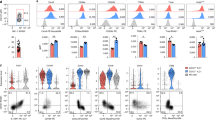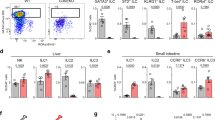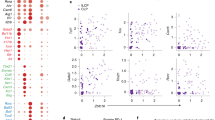Abstract
The cellular and molecular events that drive the early development of innate lymphoid cells (ILCs) remain poorly understood. We show that the transcription factor TCF-1 is required for the efficient generation of all known adult ILC subsets and their precursors. Using novel reporter mice, we identified a new subset of early ILC progenitors (EILPs) expressing high amounts of TCF-1. EILPs lacked efficient T and B lymphocyte potential but efficiently gave rise to NK cells and all known adult helper ILC lineages, indicating that they are the earliest ILC-committed progenitors identified so far. Our results suggest that upregulation of TCF-1 expression denotes the earliest stage of ILC fate specification. The discovery of EILPs provides a basis for deciphering additional signals that specify ILC fate.
This is a preview of subscription content, access via your institution
Access options
Subscribe to this journal
Receive 12 print issues and online access
$209.00 per year
only $17.42 per issue
Buy this article
- Purchase on SpringerLink
- Instant access to full article PDF
Prices may be subject to local taxes which are calculated during checkout






Similar content being viewed by others
Accession codes
References
De Obaldia, M.E. & Bhandoola, A. Transcriptional regulation of innate and adaptive lymphocyte lineages. Annu. Rev. Immunol. 33, 607–642 (2015).
Artis, D. & Spits, H. The biology of innate lymphoid cells. Nature 517, 293–301 (2015).
McKenzie, A.N., Spits, H. & Eberl, G. Innate lymphoid cells in inflammation and immunity. Immunity 41, 366–374 (2014).
Yang, Q., Jeremiah Bell, J. & Bhandoola, A. T-cell lineage determination. Immunol. Rev. 238, 12–22 (2010).
Spits, H. et al. Innate lymphoid cells—a proposal for uniform nomenclature. Nat. Rev. Immunol. 13, 145–149 (2013).
Wong, S.H. et al. Transcription factor RORα is critical for nuocyte development. Nat. Immunol. 13, 229–236 (2012).
Yang, Q., Saenz, S.A., Zlotoff, D.A., Artis, D. & Bhandoola, A. Cutting edge: natural helper cells derive from lymphoid progenitors. J. Immunol. 187, 5505–5509 (2011).
Possot, C. et al. Notch signaling is necessary for adult, but not fetal, development of RORγt+ innate lymphoid cells. Nat. Immunol. 12, 949–958 (2011).
Yu, X. et al. The basic leucine zipper transcription factor NFIL3 directs the development of a common innate lymphoid cell precursor. Elife 3, e04406 (2014).
Klose, C.S. et al. Differentiation of type 1 ILCs from a common progenitor to all helper-like innate lymphoid cell lineages. Cell 157, 340–356 (2014).
Constantinides, M.G., McDonald, B.D., Verhoef, P.A. & Bendelac, A. A committed precursor to innate lymphoid cells. Nature 508, 397–401 (2014).
van de Wetering, M., Oosterwegel, M., Dooijes, D. & Clevers, H. Identification and cloning of TCF-1, a T lymphocyte-specific transcription factor containing a sequence-specific HMG box. EMBO J. 10, 123–132 (1991).
Oosterwegel, M. et al. Cloning of murine TCF-1, a T cell-specific transcription factor interacting with functional motifs in the CD3-ɛ and T cell receptor α enhancers. J. Exp. Med. 173, 1133–1142 (1991).
Weber, B.N. et al. A critical role for TCF-1 in T-lineage specification and differentiation. Nature 476, 63–68 (2011).
Wang, R. et al. T cell factor 1 regulates thymocyte survival via a RORγt-dependent pathway. J. Immunol. 187, 5964–5973 (2011).
Germar, K. et al. T-cell factor 1 is a gatekeeper for T-cell specification in response to Notch signaling. Proc. Natl. Acad. Sci. USA 108, 20060–20065 (2011).
Goux, D. et al. Cooperating pre-T-cell receptor and TCF-1-dependent signals ensure thymocyte survival. Blood 106, 1726–1733 (2005).
Schilham, M.W. et al. Critical involvement of Tcf-1 in expansion of thymocytes. J. Immunol. 161, 3984–3991 (1998).
Verbeek, S. et al. An HMG-box-containing T-cell factor required for thymocyte differentiation. Nature 374, 70–74 (1995).
Yang, Q. et al. T cell factor 1 is required for group 2 innate lymphoid cell generation. Immunity 38, 694–704 (2013).
Mielke, L.A. et al. TCF-1 controls ILC2 and NKp46+RORγt+ innate lymphocyte differentiation and protection in intestinal inflammation. J. Immunol. 191, 4383–4391 (2013).
Ioannidis, V., Kunz, B., Tanamachi, D.M., Scarpellino, L. & Held, W. Initiation and limitation of Ly-49A NK cell receptor acquisition by T cell factor-1. J. Immunol. 171, 769–775 (2003).
Held, W., Clevers, H. & Grosschedl, R. Redundant functions of TCF-1 and LEF-1 during T and NK cell development, but unique role of TCF-1 for Ly49 NK cell receptor acquisition. Eur. J. Immunol. 33, 1393–1398 (2003).
Held, W., Kunz, B., Lowin-Kropf, B., van de Wetering, M. & Clevers, H. Clonal acquisition of the Ly49A NK cell receptor is dependent on the trans-acting factor TCF-1. Immunity 11, 433–442 (1999).
Rosmaraki, E.E. et al. Identification of committed NK cell progenitors in adult murine bone marrow. Eur. J. Immunol. 31, 1900–1909 (2001).
Fathman, J.W. et al. Identification of the earliest natural killer cell-committed progenitor in murine bone marrow. Blood 118, 5439–5447 (2011).
Carotta, S., Pang, S.H., Nutt, S.L. & Belz, G.T. Identification of the earliest NK-cell precursor in the mouse BM. Blood 117, 5449–5452 (2011).
Hoyler, T. et al. The transcription factor GATA-3 controls cell fate and maintenance of type 2 innate lymphoid cells. Immunity 37, 634–648 (2012).
Xu, W. et al. NFIL3 orchestrates the emergence of common helper innate lymphoid cell precursors. Cell Rep. 10, 2043–2054 (2015).
Seehus, C.R. et al. The development of innate lymphoid cells requires TOX-dependent generation of a common innate lymphoid cell progenitor. Nat. Immunol. 16, 599–608 (2015).
Seillet, C. et al. Nfil3 is required for the development of all innate lymphoid cell subsets. J. Exp. Med. 211, 1733–1740 (2014).
Geiger, T.L. et al. Nfil3 is crucial for development of innate lymphoid cells and host protection against intestinal pathogens. J. Exp. Med. 211, 1723–1731 (2014).
Chi, A.W. et al. Identification of Flt3(+)CD150(−) myeloid progenitors in adult mouse bone marrow that harbor T lymphoid developmental potential. Blood 118, 2723–2732 (2011).
Cherrier, M., Sawa, S. & Eberl, G. Notch, Id2, and RORγt sequentially orchestrate the fetal development of lymphoid tissue inducer cells. J. Exp. Med. 209, 729–740 (2012).
Robinette, M.L. et al. Transcriptional programs define molecular characteristics of innate lymphoid cell classes and subsets. Nat. Immunol. 16, 306–317 (2015).
Daussy, C. et al. T-bet and Eomes instruct the development of two distinct natural killer cell lineages in the liver and in the bone marrow. J. Exp. Med. 211, 563–577 (2014).
Peng, H. et al. Liver-resident NK cells confer adaptive immunity in skin-contact inflammation. J. Clin. Invest. 123, 1444–1456 (2013).
Moro, K. et al. Innate production of TH2 cytokines by adipose tissue–associated c-Kit+Sca-1+ lymphoid cells. Nature 463, 540–544 (2010).
Yokota, Y. et al. Development of peripheral lymphoid organs and natural killer cells depends on the helix-loop-helix inhibitor Id2. Nature 397, 702–706 (1999).
Sun, X.H., Copeland, N.G., Jenkins, N.A. & Baltimore, D. Id proteins Id1 and Id2 selectively inhibit DNA binding by one class of helix-loop-helix proteins. Mol. Cell. Biol. 11, 5603–5611 (1991).
Boos, M.D., Yokota, Y., Eberl, G. & Kee, B.L. Mature natural killer cell and lymphoid tissue-inducing cell development requires Id2-mediated suppression of E protein activity. J. Exp. Med. 204, 1119–1130 (2007).
Yu, S. et al. The TCF-1 and LEF-1 transcription factors have cooperative and opposing roles in T cell development and malignancy. Immunity 37, 813–826 (2012).
Schlenner, S.M. et al. Fate mapping reveals separate origins of T cells and myeloid lineages in the thymus. Immunity 32, 426–436 (2010).
Sambandam, A. et al. Notch signaling controls the generation and differentiation of early T lineage progenitors. Nat. Immunol. 6, 663–670 (2005).
Goetz, C.A. et al. Restricted STAT5 activation dictates appropriate thymic B versus T cell lineage commitment. J. Immunol. 174, 7753–7763 (2005).
De Obaldia, M.E. et al. T cell development requires constraint of the myeloid regulator C/EBP-α by the Notch target and transcriptional repressor Hes1. Nat. Immunol. 14, 1277–1284 (2013).
Bell, J.J. & Bhandoola, A. The earliest thymic progenitors for T cells possess myeloid lineage potential. Nature 452, 764–767 (2008).
Izon, D. et al. A common pathway for dendritic cell and early B cell development. J. Immunol. 167, 1387–1392 (2001).
Kolde, R. pheatmap: Pretty Heatmaps. R package version 1.0.2 http://cran.r-project.org/web/packages/pheatmap/index.html (2015).
Acknowledgements
We thank M. Greene and G. Massey for essential support. We thank the laboratories of A. Haczku, Y. Belkaid, R. Bosselut and D. Artis for technical and scientific advice. OP9-DL1 stromal cell lines were obtained from J.C. Zuniga-Pflucker (University of Toronto, Toronto, Ontario, Canada). Reagents for recombineering were kindly provided by D.L. Court (National Cancer Institute, Frederick, Maryland, USA) and N.G. Copeland (Houston Methodist Research Institute, Houston, Texas, USA). We thank T.L. Saunders at the University of Michigan for blastocyst injection of Tcf7-GFP+ embryonic stem cells. We also thank Y. Yokota (University of Fukui, Fukui, Japan) for Id2−/− mice. This work was supported by the American Cancer Society (RSG-11-161-01-MPC to H.-H.X.) and the National Institutes of Health (AI105351, AI112579, AI115149 and AI119160 to H.-H.X.; AI059621, AI098428 and HL11074103 to A.B.). A.B. is supported by the Intramural Research Program of the National Institutes of Health, the National Cancer Institute, and the Center for Cancer Research.
Author information
Authors and Affiliations
Contributions
Q.Y. performed most of the experiments with the help of C.H., L.Y., X.X., H.W. and X.W.; Tcf7GFP mice were generated by S.Y. and X.Z. and characterized by F.L. and S.X. M.C. analyzed the microarray data; Q.Y., H.-H.X. and A.B. designed the study, analyzed the data and wrote the manuscript.
Corresponding authors
Ethics declarations
Competing interests
The authors declare no competing financial interests.
Integrated supplementary information
Supplementary Figure 1 TCF-1 is required for the efficient generation of all known adult ILC subsets.
(a) The frequencies of previously described pre-NKPs, refined-purity NKPs (rNKPs) and pre-pro-NKPs were examined and compared in Tcf7+/+ and Tcf7−/− mice. (b) Gating strategies to identify different mature ILC subsets in BM LSK chimeric mice. (c) The number of cells of each mature ILC subset was measured and compared in Tcf7+/+ versus Tcf7−/− mice. (d) 5,000 Tcf7−/− LSK cells or control Tcf7+/+ LSK cells (Cd45.2) were mixed with 5,000 wild-type competitor LSK cells (CD45.1) and injected intravenously into irradiated (950 rad) recipient mice (CD45.1). Mice were analyzed at 12–16 weeks post-transplant. Representative profiles of donor chimerism are shown. (e) Donor chimerism of competitive LSK chimeras was quantified. Data are from 3–4 mice per group and are representative of two (a) or three independent experiments (b,d) or are pooled from three independent experiments (c,e). Data are presented as mean and s.e.m. *P < 0.05, **P < 0.01.
Supplementary Figure 2 Generation of the Tcf7-EGFP reporter allele.
(a) Targeting strategy. Depicted on top are a partial structure of the Tcf7 gene, transcription start sites for TCF-1 isoforms, and the conservation track from the UCSC genome browser. The resulting targeted Tcf7 allele is shown in the bottom panel, with the locations of the EGFP expression cassette, NEO cassette, two Frt sites and two LoxP sites shown. (b) Details of the targeting approach. Shown on the top is a partial structure of the Tcf7 gene, with filled bars denoting exons (all numbered), key enzyme sites, and relative locations of 5‘ and 3‘ probes used in Southern blotting. Shown at the bottom is the structure of the resulting targeted Tcf7 allele, highlighting the targeting arms in the targeting construct. Note that an extra BamHI site was inserted immediately after the downstream LoxP site, and an extra ApaLI was embedded in the EGFP expression cassette. These two extra enzyme sites were used to facilitate detection of the targeted allele by Southern blotting. (c) Identification of ES clones with expected homologous recombination. Genomic DNA was extracted from ES cell clones generated after targeting construct electroporation and selection, digested with ApaL1, and blotted with the 5‘ probe, which detects the wild-type allele at approximately 9.4 kb and the targeted allele at approximately 6.6 kb (left panel). Another portion of genomic DNA was digested with BamHI and blotted with the 3‘ probe, which detects the WT allele at about 9.8 kb and the targeted allele at about 7 kb (right panel). The primers used in Southern blotting were as follows: 5‘ probe, 5‘-gcaccatgatcctgtttgat and 5‘-gcgcgtttttaaacatgtgag; 3‘ probe, 5‘-ccctagcagctcatcagacc and 5‘-ctctggcccacagtagaagc. (d) Confirmation of GFP expression in T cells of Tcf7GFP mice. Representative flow cytometric plots depict the GFP expression of thymus DP cells and spleen T and B cells in Tcf7GFP (green) or control mice (gray). (e) Representative flow cytometric plots depicting GFP expression in the indicated susbets of Tcf7GFP (green) or control mice (open histogram). Data are representative of three independent experiments (c–e).
Supplementary Figure 3 EILPs developed into ILCs in vitro.
(a,b) 100 EILPs or CLPs were plated on OP9 (a) or OP9-DL1 (b) stroma in the presence of FL (5 ng/ml) and IL-7 (1 ng/ml or 10 ng/ml). The emergence of progeny was examined after 10 days of culture. (c) 100 EILPs were cultured with OP9 stroma in the presence of SCF (30 ng/ml), IL-7 (30 ng/ml), and IL-2 (30 ng/ml). Cultures were examined after 10 days. (d) EILPs and the other indicated BM and thymus early progenitors were sorted by flow cytometry cell sorting, and genome-wide microarray analysis was performed. The heat map shows the expression levels of canonical genes for validation of the microarray analysis. Data are representative of three independent experiments (a–c).
Supplementary Figure 4 Functional EILPs are not detected in the thymus.
(a) 10 EILPs were cultured on OP9 stroma with the indicated cytokines for 10 days. Expansion rates were examined as the number of CD45+ progeny that emerged per progenitor input. (b) Single EILPs were plated on OP9 stroma at one EILP per well in 96-well plates in the presence of SCF, IL-2 and IL-7 for 10 days. The bar graph indicates the percentage of positive wells that contained more than 10 CD45+ daughter cells. (c) 100 EILPs, LMPPs, CLPs and ETPs were cultured on OP9 stroma for 7 days in the presence of SCF, IL-2, and IL-7. The number of progeny per cell input was examined by flow cytometry. (d) Representative flow profiles of thymocytes of Tcf7GFP mice. Plots were gated on thymus Lin− cells. A few cells with the EILP phenotype (Lin−TCF-1+Thy-1−IL-7Ralo-neg) were identified, among which some expressed α4β7. (e) Thymus α4β7+ and α4β7− EILP-like cells (Lin−TCF-1+Thy-1.2−IL-7Ralo-neg) were sorted and cultured on OP9 stroma for 7 days in the presence of SCF, IL-2, and IL-7. The number of progeny was examined by flow cytometry. BM EILPs were used as a positive control. The bar graph shows the number of progeny per progenitor cell input. Data are from three wells per group (a), five independent experiments (b) or three independent experiments (c,e) or are representative of three independent experiments (d). Data are presented as mean and s.e.m. *P < 0.05, **P < 0.01.
Supplementary Figure 5 Id2−/− EILP failed to give rise to B and T lymphocytes in vitro
(a) 200 CLP or EILP from Id2+/+ or Id2−/− mice were sorted and cultured on OP9 in the presence of FL (5ng/ml) and IL-7 (10ng/ml). The emergence of progeny was examined after 7 days of culture. (b) 200 CLP or EILP from Id2+/+ or Id2-/- mice were sorted and cultured on OP9-DL1 in the presence of FL (5ng/ml) and IL-7 (10ng/ml). The emergence of progeny was examined after 7 days of culture. Data are representative of three independent experiments.
Supplementary Figure 6 Model of early ILC development
Diagram depicts a model for early ILC development.
Supplementary information
Supplementary Text and Figures
Supplementary Figures 1–6 (PDF 902 kb)
Supplementary Table 1
List of antibodies used for flow cytometry analysis (XLS 30 kb)
Rights and permissions
About this article
Cite this article
Yang, Q., Li, F., Harly, C. et al. TCF-1 upregulation identifies early innate lymphoid progenitors in the bone marrow. Nat Immunol 16, 1044–1050 (2015). https://doi.org/10.1038/ni.3248
Received:
Accepted:
Published:
Issue Date:
DOI: https://doi.org/10.1038/ni.3248
This article is cited by
-
TCF-1 promotes chromatin interactions across topologically associating domains in T cell progenitors
Nature Immunology (2022)
-
Leaving no one behind: tracing every human thymocyte by single-cell RNA-sequencing
Seminars in Immunopathology (2021)
-
An engineered IL-2 partial agonist promotes CD8+ T cell stemness
Nature (2021)
-
The interplay between innate lymphoid cells and T cells
Mucosal Immunology (2020)
-
HIV-1-induced cytokines deplete homeostatic innate lymphoid cells and expand TCF7-dependent memory NK cells
Nature Immunology (2020)



